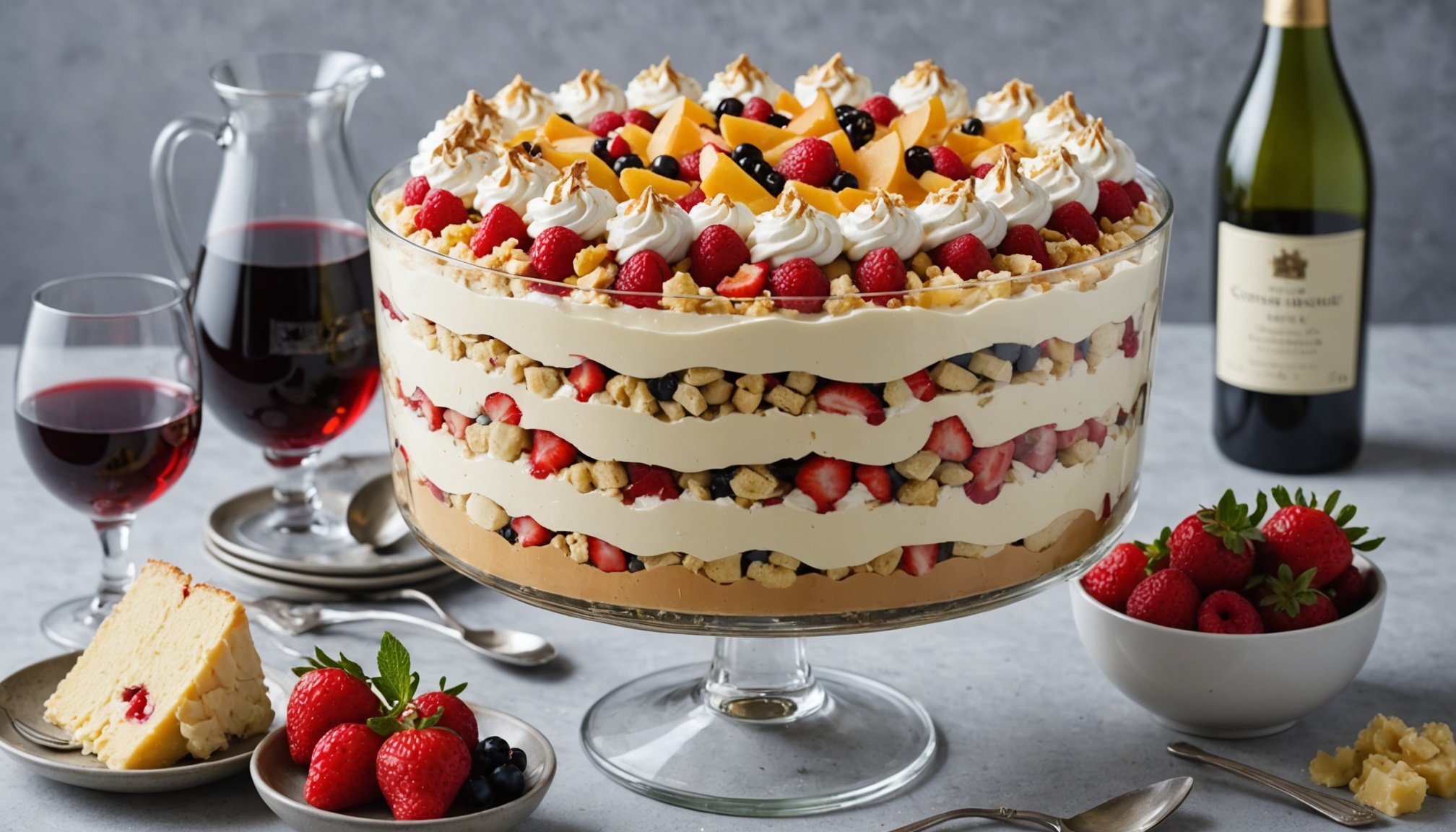Recipe Overview
The sherry-infused trifle recipe offers a deliciously indulgent experience, blending creamy layers with a touch of luxury. This version of the classic English dessert introduces sherry, enhancing both its depth of flavour and sophistication. When preparing this dessert, the choice of sherry is crucial. High-quality sherry not only enriches the taste but also brings out the delicate notes in the trifle’s layers.
Perfect for special gatherings, this decadent dessert stands out during festivities or intimate dinners. The layers, typically comprising sponge cake, custard, and fresh fruits, are elegantly accentuated with the elegance of sherry. Such a treat promises to impress guests and elevate your culinary repertoire. Whether you’re serving it at a holiday feast or a weekend family dinner, the sherry-infused trifle ensures a memorable and satisfying end to any meal.
Additional reading : Unlocking the Art of a Luxuriously Creamy Mascarpone and Fig Cheesecake: Secrets Revealed!
For those looking to explore or innovate with classic desserts, this trifle with its sherry twist is both captivating and inviting.
Ingredients List
An English trifle is a delightful dessert layered with harmonious flavours and textures. Preparing it involves selecting quality ingredients that complement each other. Below is a detailed list of ingredients for a classic English trifle:
Additional reading : Unveiling the secrets of the burger king mystery box
- Sponge cake: 8 oz, cut into bite-sized cubes.
- Sherry: 1 cup, crucial for soaking and infusing the sponge with flavour. A rich sherry brings depth.
- Jam: 4 tbsp, preferably raspberry or strawberry for sweetness.
- Custard: 2 cups, creamy and smooth for the middle layer’s indulgence.
- Whipping cream: 2 cups, whipped until soft peaks form for a light, airy top layer.
- Fresh berries: 1 cup, a mix of strawberries, raspberries, and blueberries for freshness.
The importance of proper ingredient selection cannot be overstated. Sherry and cream are vital in achieving the perfect taste. For those with dietary restrictions, consider substituting:
- Non-alcoholic fruit juice for sherry
- Dairy-free custard and cream alternatives
- Sugar-free or low-sugar jam and cake
Choosing quality ingredients tailored to individual preferences ensures the trifle remains a crowd-pleaser. Understanding the finesse in ingredient selection can elevate this traditional dessert to new heights while accommodating varied dietary needs.
Preparation Time and Method
In creating the perfect trifle, understanding the preparation instructions is crucial. Begin by allocating time wisely: set aside around 30 minutes for assembling each component, followed by at least two hours for chilling to ensure a delectable fusion of flavours and textures.
Assembling the Trifle
Start with a layer of sponge cake, generously doused in sherry or juice to keep it moist. Follow with a thick layer of custard, ensuring an even spread over the sponge to avoid lumps. Next, add layers of fresh fruit like berries or bananas, providing a balance of sweetness and tartness.
Repeat these layers, ensuring each is saturated with flavours. The final touch is a luscious creamy texture, which can be achieved by whisking heavy cream until it forms soft peaks. Carefully spoon this over your trifle for a sumptuous top layer.
Key Techniques
The trifle’s creamy texture is achieved by softening the custard just right. For custard, constantly stir over moderate heat until it thickens, avoiding any curdling. Meanwhile, for the whipped cream, ensure a smooth consistency for the perfect finish. Remember, patience during the chilling phase is key to allowing flavours to meld thoroughly.
Serving Suggestions
When it comes to how to serve English trifle, presentation plays a pivotal role. To start, consider layering the ingredients in a clear glass bowl. This vessel will showcase the vibrant layers of sponge, custard, and fruit, making the desert visually enticing. For an elegant touch, garnish the trifle with a sprinkle of fresh mint leaves or a dash of grated dark chocolate.
Selecting the right serving size is paramount. Individual servings in stemless wine glasses or small glass jars offer a personalised touch, allowing guests to savour the distinct flavours without overwhelming portions. These smaller servings not only look sophisticated but also help in portion control.
Pairing trifles with complementary beverages can elevate the dining experience. A glass of chilled dessert wine or a delicate Earl Grey tea can enhance the dessert’s flavours. Additionally, serving English trifle as a light ending after a heavy main course, such as a traditional Sunday roast, can balance the meal beautifully.
Remember, the key to a memorable trifle experience lies in the details. Whether it’s the striking presentation, the thoughtful portioning, or the carefully chosen pairing, each aspect contributes to a delightful culinary moment.
Tips for Achieving the Perfect Trifle
To create a mesmerising trifle, mastering the techniques for layering ingredients is essential. Begin by choosing the right vessel, preferably clear, to showcase each beautiful layer. Start with a sturdy base like sponge cake or ladyfingers to soak up flavours while providing support. Alternate layers of moist and dry ingredients to prevent any single element from overwhelming the dish.
Enhancing your trifle with diverse flavour profiles ensures a delightful tasting experience. Balance is key; use tart fruits to counteract sweet creams, and consider adding subtle notes such as vanilla or almond extracts to heighten flavours without overpowering. Incorporate textures through crunchy nuts or delicate gelatin to complement the creamy layers.
Remember, optimal chilling time is crucial for a cohesive trifle. Allow your creation to rest in the refrigerator for at least four hours, ideally overnight, before serving. This patience ensures flavours meld seamlessly and reach their peak potential, while also allowing textures to firm up appropriately. Following these trifle preparation tips, you’ll achieve a dessert as beautiful to behold as it is to taste.
Variations of the Trifle Recipe
Exploring alternative trifle variations can transform a classic dessert into a delightful, ever-changing treat. One way to modify the traditional recipe is by swapping fruits and creams to cater to different tastes and dietary preferences. Consider using tropical fruits like mango and pineapple for a summer twist, or opt for berries and pomegranate seeds in winter, adding colour and a fresh burst of flavour.
For those seeking lower-calorie options, try incorporating lighter creams such as Greek yogurt or fat-free whipped topping instead of traditional custard. These alternatives maintain the dessert’s creaminess without the added richness, appealing to health-conscious dessert enthusiasts.
Moreover, trifle can be adapted beyond standard flavours by exploring alcohol-free recipes, ideal for family-friendly gatherings. Replace sherry or liqueur with juice, syrup, or even infused water options. This ensures flavourful moist layers without compromising on the dessert’s essence.
Seasonal trifle variations celebrate distinct flavours of the time — imagine autumn-inspired trifles with spiced apples and caramel, capturing the warmth of fall. Virtually any ingredient combination can be used to adapt this versatile recipe, making it a favourite customised dessert for any occasion.
Nutritional Information
When examining the English trifle nutrition facts, it is crucial to look closely at the nutritional content per serving. A traditional serving of English trifle typically contains a rich mix of ingredients, offering an average of 350-500 calories. This range largely depends on the proportions of cream, custard, and sponge cake used. However, the sweet indulgence also brings notable quantities of sugars and fats.
Sharing sizes of trifle means that calorie intake can vary significantly, especially if larger portions are served. It’s worth noting that even smaller servings can easily become calorie-dense snacks throughout the day. To align with different dietary frameworks, consider adapting the trifle’s recipe. Using sugar-free custard or opting for low-fat cream alternatives can significantly reduce calorie content, catering to specific nutritional needs.
For those following gluten-free diets, gluten-free sponge can be used seamlessly. By making these practical adjustments, individuals can enjoy this classic dessert without deviating from their dietary preferences. Remember, understanding how to adapt a recipe helps maintain a balance between flavour and nutritional values, allowing anyone to relish in a delightful dessert experience while staying mindful of health goals.
User Comments and Reviews
Exploring trifle recipe reviews offers a wealth of insights into how different individuals experience and innovate with this classic dish. Many users highlight specific tweaks that make substantial improvements. For instance, adding a splash of brandy or using fresh berries instead of canned ones can significantly elevate the flavours.
One common challenge individuals encounter is achieving the perfect consistency of custard. To address this, reviewers often suggest chilling it slightly before layering. This ensures that it holds its shape, creating a visually appealing dessert that stays intact upon serving.
Feedback often includes creative suggestions, like substituting traditional sponge cake with savoiardi biscuits for an added textural contrast. These enhancements show how modifications can lead to more personalised trifle experiences.
Readers are encouraged to experiment and share their own experiences. Whether it’s a substitution that worked wonders or a new twist to the layering order, every contribution helps forge a community of inspired trifle enthusiasts. Engaging with these reviews not only helps in perfecting one’s technique but also supports others in their culinary journeys. So, don’t hesitate to leave your own take on this delightful dessert!











